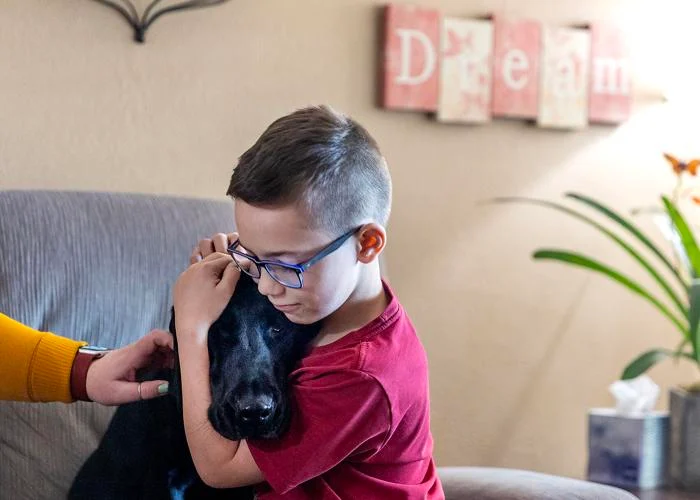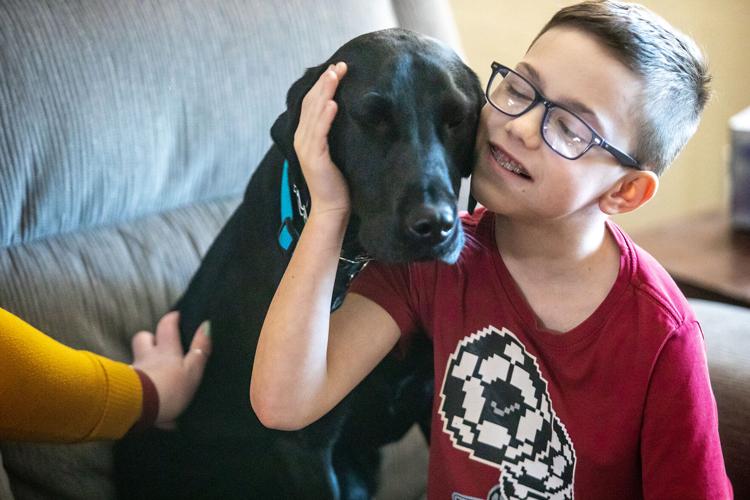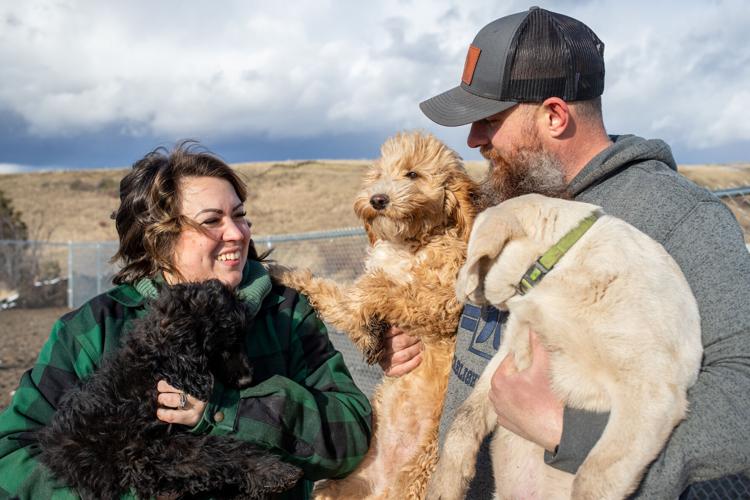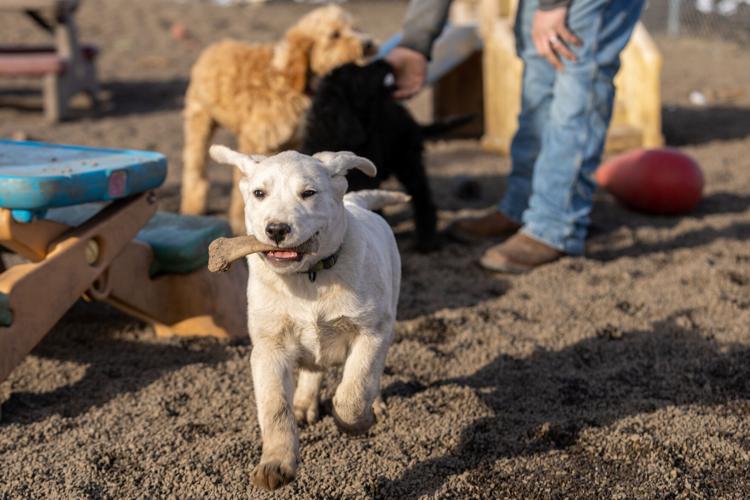
A boy, his dog, and a new lease on life
Listen
(Runtime 1:17)
Read
When 9-year-old Roman Mack returns home from school, his black labrador retriever, Otto, is always waiting eagerly for his return. Ever since the two met last year, they’ve been inseparable, said Roman’s mother Morgan Frakes.
Otto follows Roman everywhere. When Roman is at home, Otto is tailing him. When he’s at soccer practice, Otto watches, waiting for Roman to return to his side. As Morgan talks, her son sits cradling Otto’s head and whispering to his dog.

Roman Mack sits with his diabetic alert dog, Otto, in their Lewiston home on March 6. (Credit: August Frank / The Lewiston Tribune)
“Really, he just followed [Roman] around right from the day we got him,” Morgan said. “It’s kind of crazy.”
In many ways, Otto and Roman’s story is typical of any child and his dog. But Otto is more than just a four-legged friend; Otto, a diabetic alert dog, is Roman’s guardian.
In February of last year, Roman was rushed to the pediatric intensive care unit at Sacred Heart Children’s Hospital in Spokane, Washington. There, he and his family learned he had Type 1 diabetes, a chronic condition where the pancreas produces little or no insulin. The condition typically appears in childhood.
What followed was a crash course in caring for her diabetic child, Morgan said, and months of adjusting to insulin shots and finger pricks for Roman.
“It’s kind of stressful sometimes,” Roman said. “Because you’re taking one thing, just straight to another.
Morgan also had to get used to late nights as they worked to regulate her son’s blood sugar, she said.
“Those first couple of months, really, it’s like having a newborn again,” she said. “I have to wake him up and give him juice constantly to keep his blood sugars up.”
Since his diagnosis, Roman has used a continuous glucose monitor that provides alerts for low blood sugar. But relying on the monitor alone was stressful, Morgan said. The alerts woke her up the first few months, she said, but after awhile she started to sleep through them.
Diabetic alert dogs like Otto use their sense of smell to detect changes in their owner’s blood sugar levels. If Frakes sleeps through an alert, Otto will wake her up. He’s also able to detect changes before the blood sugar monitor picks them up.
Diabetic alert dogs’ noses are also more sensitive than glucose monitors, said Mitch Bowen, trainer and owner at Bowen Elite Service Dogs.
“The sensors can be 15 to 20 minutes behind what an actual blood sugar is,” Mitch Bowen said. “So, that’s when a dog can be more accurate and even catch lows or highs before it happens.”
Morgan and Roman first met Mitch and Stephanie Bowen through their local nonprofit and diabetic support group the couple runs, Hometown T1D, after Roman’s diagnosis. The Bowens, who first started training diabetic alert dogs after their daughter Addy was diagnosed in 2018, brought a care package to the family’s door.
After seeing how Addy’s diabetic alert dog, an Australian labradoodle named Milo, helped her, the couple decided to start their own business to raise and train diabetic alert dogs.
“It’s been an amazing process and an amazing gift that he’s been for Addy,” Mitch Bowen said. “We knew that we wanted to give that to others.”

Stephanie and Mitch Bowen hold, from left to right, Moose, Dolly and Tucker. The three puppies will eventually become diabetic alert dogs when they’ve completed training. (Credit: Austin Johnson / The Lewiston Tribune)
Roman’s dog, Otto, had previously been placed in a home that didn’t suit the dog. Otto needed a placement where he could continue training with the Bowens and be an at-home alert dog.
Training can be costly. Usually, between the Bowens’ charges, breeder fees and other expenses, costs can total around $30,000. But for Roman, the Bowens offered to place Otto at a reduced cost. After a GoFundMe covered around $4,200, Hometown T1D donated the rest of the funds, amounting to roughly $14,000, Morgan said.
The dogs are trained for months to detect high and low blood sugar levels with their specific owner’s scent, Stephanie Bowen said. Clients send saliva samples taken during low and high blood sugar events, as well as samples from when they’re in the normal blood sugar range. Those are frozen, and sent overnight to the Bowens.
There, the Bowens train the dogs to recognize the differences and reward the dogs for alerting for high and low blood sugar.
After about two months, the young dogs are able to consistently pick up those scents and alert by pawing, or “booping” with their nose, Stephanie Bowen said. The Bowens spend months reinforcing that training in different environments and at different times of day.

Tucker, a yellow labrador retriever puppy, runs through the exercise yard at Stephanie and Mitch Bowen’s home in Lapwai, Idaho. (Credit: Austin Johnson / The Lewiston Tribune)
Morgan is also hopeful that Otto will help her son gain independence. In many ways, Roman’s Type 1 diabetes has complicated his life. In school, Roman often must explain his condition to his classmates.
Some people, Roman said, don’t understand the difference between his Type 1 diabetes, which is a genetic condition that shows up early in life, and Type 2 diabetes, which develops over time and is often lifestyle related. Sometimes he’ll even have to explain to classmates that he’s not contagious.
“One guy, he’s like, ‘Aren’t you the guy who has rabies?’” Roman said. “I’m like, ‘It’s diabetes!’”
But having Otto, Morgan said, makes it easier for Roman to do what he loves — and gives her a sense of security for her son.
“It makes me feel a lot better just to know that, especially as Roman gets older and he’s going to be out doing more, and maybe not paying attention to his diabetes as much, that he has this dog that will always just be there to help him and protect him,” Frakes said.
This report is made possible by a cooperative agreement with NWPB, the Lewiston Tribune and the Moscow-Pullman Daily News.















